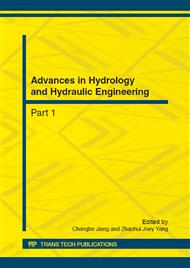[1]
E. Alperovits and U. Shamir. Design of optimal water distribution systems. Water Resources Research 13(6), pp.885-900 (1977).
DOI: 10.1029/wr013i006p00885
Google Scholar
[2]
A. El-Bahrawy and A.A. Smith. Application of MINOS to water collection and distribution networks. Civil Engineering Systems 2(1), pp.38-49 (1985).
DOI: 10.1080/02630258508970379
Google Scholar
[3]
N. Duan, L.W. Mays and K.E. Mansey. Optimal reliability-based design of pumping and distribution systems. J. Hydraulic Engineering 116(2), pp.249-268 (1990).
DOI: 10.1061/(asce)0733-9429(1990)116:2(249)
Google Scholar
[4]
A.R. Simpson, G.C. Dandy and L.J. Murphy. Genetic algorithm compared to other techniques for pipe optimization. J. Water Resour. Plann. Manage. 120(4), pp.423-443 (1994).
DOI: 10.1061/(asce)0733-9496(1994)120:4(423)
Google Scholar
[5]
D.A. Savic and G.A. Walters. Genetic algorithms for least-cost design of water distribution networks. Journal of Water Resources Planning and Management 123(2), pp.67-77 (1997).
DOI: 10.1061/(asce)0733-9496(1997)123:2(67)
Google Scholar
[6]
P. Montesinos, A. Garcia-Guzman and J.L. Ayuso. Water distribution network optimization using a modified genetic algorithm. Water Resources Research 35(11), pp.3467-3473 (1999).
DOI: 10.1029/1999wr900167
Google Scholar
[7]
K. Deb, Multi-objective optimization using evolutionary algorithms, New York: Wiley (2001).
Google Scholar
[8]
T. D. Prasad and N. S. Park. Multi-objective genetic algorithms for design of water distribution networks, J. Water Resour. Plann. Manage. 130(1), pp.73-82 (2004).
DOI: 10.1061/(asce)0733-9496(2004)130:1(73)
Google Scholar
[9]
M. Nicolini. A two-level evolutionary approach to multi-criterion optimization of water supply systems, in Evolutionary Multi-Criterion Optimization, C. A. Coello Coello et al, Eds., LNCS 3410, Berlin: Springer-Verlag, pp.736-751 (2005).
DOI: 10.1007/978-3-540-31880-4_51
Google Scholar
[10]
G. C. Dandy and M. O. Engelhardt. Multi-objective trade-offs between cost and reliability in the replacement of water mains, J. Water Resour. Plann. Manage. 132(2), pp.79-88 (2006).
DOI: 10.1061/(asce)0733-9496(2006)132:2(79)
Google Scholar
[11]
S. Sun, S. T. Khu, Z. Kapelan and S. Djordjevic. A fast approach for multi-objective design of water distribution networks under demand uncertainty, J. Hydroinf. 12(2), pp.143-152 (2011).
DOI: 10.2166/hydro.2010.033
Google Scholar
[12]
D.F. Yates, A.B. Templeman and T.B. Boffey. The computational complexity of the problem of determining least capital cost designs for water supply networks. Engineering Optimization 7(2), pp.142-155 (1984).
DOI: 10.1080/03052158408960635
Google Scholar
[13]
E. Todini. Looped water distribution networks design using a resilience index based heuristic approach, Urban Water, 2, pp.115-122 (2000).
DOI: 10.1016/s1462-0758(00)00049-2
Google Scholar
[14]
L.A. Rossman, EPANET 2 Users Manual, Cincinnati, Ohio. United States Environmental Protection Agency (2000).
Google Scholar
[15]
K. Deb, A. Pratap and S. Agarwal, A fast and elitist multi-objective genetic algorithm: NSGA-II, IEEE Trans. on Evolutionary Computation, 6(2), pp.182-197 (2002).
DOI: 10.1109/4235.996017
Google Scholar
[16]
M. Wall, GAlib: a C++ library of genetic algorithm components, Mechanical Engineering Department, Massachussets Institute of Technology (2000).
Google Scholar
[17]
M. Nicolini and L. Zovatto. Optimal location and control of pressure reducing valves in water networks, J. Water Resour. Plann. Manage. 135(3), pp.178-187 (2009).
DOI: 10.1061/(asce)0733-9496(2009)135:3(178)
Google Scholar
[18]
M. Nicolini, C. Giacomello and K. Deb. Calibration and optimal leakage management for a real water distribution network, J. Water Resour. Plann. Manage. 137(1), pp.134-142 (2011).
DOI: 10.1061/(asce)wr.1943-5452.0000087
Google Scholar


